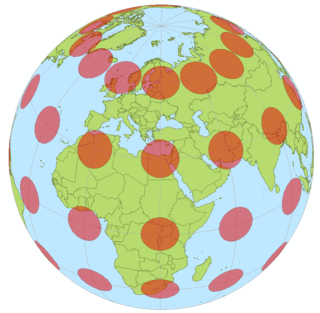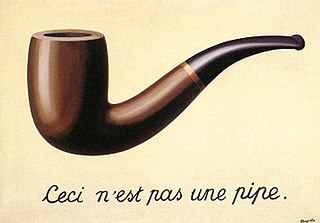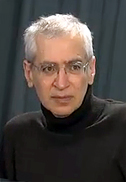Postmodernism is an intellectual stance or mode of discourse characterized by skepticism towards elements of the Enlightenment worldview. It questions the "grand narratives" of modernism, rejects the certainty of knowledge and stable meaning, and acknowledges the influence of ideology in maintaining political power. The idea of objective claims is dismissed as naïve realism, emphasizing the conditional nature of knowledge. Postmodernism embraces self-referentiality, epistemological relativism, moral relativism, pluralism, irony, irreverence, and eclecticism. It opposes the "universal validity" of binary oppositions, stable identity, hierarchy, and categorization.
Truth or verity is the property of being in accord with fact or reality. In everyday language, truth is typically ascribed to things that aim to represent reality or otherwise correspond to it, such as beliefs, propositions, and declarative sentences.

Jean Baudrillard was a French sociologist, philosopher and poet with interest in cultural studies. He is best known for his analyses of media, contemporary culture, and technological communication, as well as his formulation of concepts such as hyperreality. Baudrillard wrote about diverse subjects, including consumerism, critique of economy, social history, aesthetics, Western foreign policy, and popular culture. Among his most well-known works are Seduction (1978), Simulacra and Simulation (1981), America (1986), and The Gulf War Did Not Take Place (1991). His work is frequently associated with postmodernism and specifically post-structuralism. Nevertheless, Baudrillard had also opposed post-structuralism and had distanced himself from postmodernism.
Hyperreality is a concept in post-structuralism that refers to the process of the evolution of notions of reality, leading to a cultural state of confusion between signs and symbols invented to stand in for reality, and direct perceptions of consensus reality. Hyperreality is seen as a condition in which, because of the compression of perceptions of reality in culture and media, what is generally regarded as real and what is understood as fiction are seamlessly blended together in experiences so that there is no longer any clear distinction between where one ends and the other begins.

The map–territory relation is the relationship between an object and a representation of that object, as in the relation between a geographical territory and a map of it. Mistaking the map for the territory is a logical fallacy that occurs when someone confuses the semantics of a term with what it represents. Polish-American scientist and philosopher Alfred Korzybski remarked that "the map is not the territory" and that "the word is not the thing", encapsulating his view that an abstraction derived from something, or a reaction to it, is not the thing itself. Korzybski held that many people do confuse maps with territories, that is, confuse conceptual models of reality with reality itself. These ideas are crucial to general semantics, a system Korzybski originated.
"On Exactitude in Science" or "On Rigor in Science" is a one-paragraph short story written in 1946 by Jorge Luis Borges, about the map–territory relation, written in the form of a literary forgery.

The Gulf War Did Not Take Place is a collection of three short essays by Jean Baudrillard published in the French newspaper Libération and British paper The Guardian between January and March 1991.

The Treachery of Images is a 1929 painting by Belgian surrealist painter René Magritte. It is also known as This Is Not a Pipe and The Wind and the Song. Magritte painted it when he was 30 years old. It is on display at the Los Angeles County Museum of Art.

White Noise is the eighth novel by Don DeLillo, published by Viking Press in 1985. It won the U.S. National Book Award for Fiction.
French philosophy, here taken to mean philosophy in the French language, has been extremely diverse and has influenced Western philosophy as a whole for centuries, from the medieval scholasticism of Peter Abelard, through the founding of modern philosophy by René Descartes, to 20th century philosophy of science, existentialism, phenomenology, structuralism, and postmodernism.

Hyperrealism is a genre of painting and sculpture resembling a high-resolution photograph. Hyperrealism is considered an advancement of photorealism by the methods used to create the resulting paintings or sculptures. The term is primarily applied to an independent art movement and art style in the United States and Europe that has developed since the early 1970s. Carole Feuerman is the forerunner in the hyperrealism movement along with Duane Hanson and John De Andrea.
Semiotext(e) is an independent publisher of critical theory, fiction, philosophy, art criticism, activist texts and non-fiction.
A simulacrum is a representation or imitation of a person or thing. The word was first recorded in the English language in the late 16th century, used to describe a representation, such as a statue or a painting, especially of a god. By the late 19th century, it had gathered a secondary association of inferiority: an image without the substance or qualities of the original. Literary critic Fredric Jameson offers photorealism as an example of artistic simulacrum, in which a painting is created by copying a photograph that is itself a copy of the real thing. Other art forms that play with simulacra include trompe-l'œil, pop art, Italian neorealism, and French New Wave.

Sylvère Lotringer was a French-born literary critic and cultural theorist. Initially based in New York City, he later lived in Los Angeles and Baja California, Mexico. He is best known for synthesizing French theory with American literary, cultural and architectural avant-garde movements as founder of the journal Semiotext(e) and for his interpretations of theory in a 21st-century context. He is regarded as an influential interpreter of Jean Baudrillard's theories, among others.
In philosophy, genealogy is a historical technique in which one questions the commonly understood emergence of various philosophical and social beliefs by attempting to account for the scope, breadth or totality of discourse, thus extending the possibility of analysis. Moreover, a genealogy often attempts to look beyond the discourse in question toward the conditions of their possibility. It has been developed as a continuation of the works of Friedrich Nietzsche. Genealogy is opposed to the Marxist use of the ideology to explain the totality of historical discourse within the time period in question by focusing on a singular or dominant discourse (ideology).

Welcome to the Desert of the Real is a 2002 book by Slavoj Žižek. A Marxist and Lacanian analysis of the ideological and political responses to the terrorist attacks on September 11, 2001, Zizek's study incorporates various psychoanalytic, postmodernist, biopolitical, and (Christian) universalist influences into a Marxist dialectical framework.

Alan N. Shapiro is an American science fiction and media theorist. He is a lecturer and essayist in the fields of science fiction studies, media theory, posthumanism, French philosophy, creative coding, technological art, sociology of culture, social choreography, software theory, robotics, artificial intelligence, and futuristic and transdisciplinary design. Shapiro's book and other published writings on Star Trek have contributed to a change in public perception about the importance of Star Trek for contemporary culture. His published essays on Jean Baudrillard - especially in the International Journal of Baudrillard Studies - have contributed to a change in public perception about the importance of Baudrillard's work for culture, philosophy, sociology, and design.

Girl Imagined by Chance is a postmodern novel by Lance Olsen, published in 2002 by Fiction Collective Two. It is a work of metafiction designed to trouble the unexamined assumptions of the memoir.
Hyper-real religion is a sociological term to describe a new consumer trend in acquiring and enacting religion. The term was first described in the book Religion and Popular Culture: A Hyper-Real Testament by Adam Possamai. The term is used to explore the intersection between postmodernity and religion. The idea has been expanded and critiqued by a number of academics since its creation.
Fuoco B. Fann, is a cultural theorist. He is noted for synthesizing Post-structuralism with American Literary Criticism, Intercultural Philosophy, and Material Culture Studies. He taught at Lanzhou Jiaotong University, China before moving in 1989 to the United States, where he guest-lectured at California State University, East Bay and UC Davis, and has since resided in California. Fann’s monograph on post-structuralism and intercultural philosophy, This Self We Deserve: A Quest after Modernity, was published in 2020.










